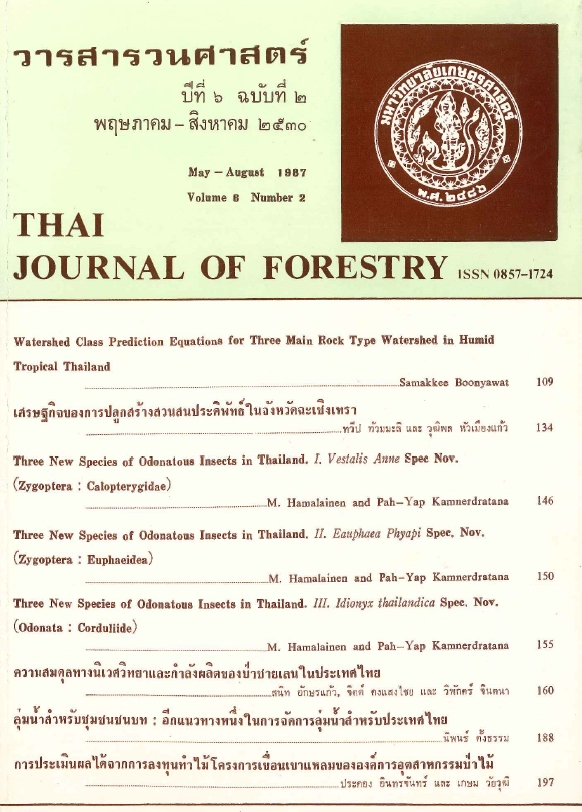WATERSHED CLASS PREDICTION EQUATIONS FOR THREE MAIN ROCK TYPE WATERSHED IN HUMID TROPICAL THAILAND
Main Article Content
บทคัดย่อ
A watershed class prediction equation in Thailand was proposed by Wooldridge (1984). The equation is a multiple linear regression which was developed using five variables. i.e., slope, elevation, landform, soil and geology without any transformation. Theory, however, suggests that the relationship between watershed class and the explanatory variables in not linear and the original equation requires too many variables. Therefore, linearized models were developed using one to five explanatory variables.
An analysis of the different equations tested showed that the equation using logarithmic transformation at the right side of the equation was the most appropriate form. Therefore, this form of the equation was used to develop the equations to predict watershed classes for the three rock type watersheds.
Watershed class prediction equations for all rock types taken together and each rock type considered individually, namely: granite, sandstone and limestone were developed from 300 randomly selected grids of each rock type of northern Thailand. Several variable combinations were used to develop the regression. equation for watershed classes. The equations having the highest R were selected for field validation. Field validation was necessary to verify the usefulness and accuracy of these selected equations together with the Wooldridge equation. Eight selected watersheds were used three watershed areas each for granite and sandstone rock type and only two watershed areas of limestone rock type due to unavailability of additional data on this rock type watershed.
For the granite and limestone rock type watersheds, it was observed that slope alone is sufficiently adequate to predict watershed class. This is due to the strong direct correlation between slope and soil erosion rate and land use in these watersheds.
For the sandstone rock type watershed, slope alone is not adequate to accurately predict watershed class. This is due to the presence of flat areas on top of these mountain watersheds. This condition is not distinctly present in the granite and limestone rock type watersheds. The inclusion of landform and elevation into the equation makes the model sufficiently accurate in predicting watershed class for the sandstone rock type watershed.
For a single comprehensive watershed class prediction equation, a regres sion model with dummy variables for the three rock type was developed. The model has slope, elevation, landform, soil and rock type as explanatory variables with zero-one variables representing the rock types. If resources are not limited this equation could be used to determine watershed class for the three rock type watersheds instead of using three separate equations. On the other hand, if time is a constraint, the simpler model using one to three variables could be used to predict the watershed class for each rock type watershed.
Downloads
Article Details

อนุญาตภายใต้เงื่อนไข Creative Commons Attribution-NonCommercial-NoDerivatives 4.0 International License.
ข้าพเจ้าและผู้เขียนร่วม (ถ้ามี) ขอรับรองว่า ต้นฉบับที่เสนอมานี้ยังไม่เคยได้รับการตีพิมพ์และไม่ได้อยู่ในระหว่างกระบวนการพิจารณาตีพิมพ์ลงในวารสารหรือสิ่งตีพิมพ์อื่นใด ข้าพเจ้าและผู้เขียนร่วม (ถ้ามี) ยอมรับหลักเกณฑ์และเงื่อนไขการพิจารณาต้นฉบับ ทั้งยินยอมให้กองบรรณาธิการมีสิทธิ์พิจารณาและตรวจแก้ต้นฉบับได้ตามที่เห็นสมควร พร้อมนี้ขอมอบลิขสิทธิ์ผลงานที่ได้รับการตีพิมพ์ให้แก่วารสารวนศาสตร์ คณะวนศาสตร์ มหาวิทยาลัยเกษตรศาสตร์ กรณีมีการฟ้องร้องเรื่องการละเมิดลิขสิทธิ์เกี่ยวกับภาพ กราฟ ข้อความส่วนใดส่วนหนึ่ง หรือ ข้อคิดเห็นที่ปรากฏในผลงาน ให้เป็นความรับผิดชอบของข้าพเจ้าและผู้เขียนร่วม (ถ้ามี) แต่เพียงฝ่ายเดียว และหากข้าพเจ้าและผู้เขียนร่วม (ถ้ามี) ประสงค์ถอนบทความในระหว่างกระบวนการพิจารณาของทางวารสาร ข้าพเจ้าและผู้เขียนร่วม (ถ้ามี) ยินดีรับผิดชอบค่าใช้จ่ายทั้งหมดที่เกิดขึ้นในกระบวนการพิจารณาบทความนั้น”


